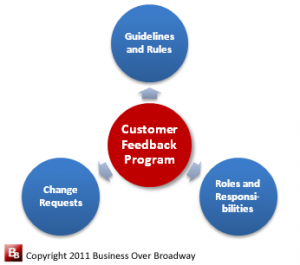Below is the next installment of the 20 Best Practices for Customer Feedback Programs. Today’s post covers best practices in Strategy and Governance.
Strategy/Governance Best Practices
Strategy
Strategy reflects the overarching, long-term plan of a company that is designed to help the company attain a specific goal. For customer-centric companies, the strategy is directed at improving the customer experience.
A successful customer feedback program is dependent on the support of top management. Any company initiative (including a customer-centric initiative) without the full support of senior executives will likely fail.
The company culture is directly impacted by senior executives. Because loyalty leaders understand that the formal company strategy and accompanying mission statement set the general culture of the company, they embed the importance of the customer into their mission statements. These customer-centric mission statements instill a set of company values and implicit performance standards about addressing customers’ needs. The customer-centric standards shared among the employees act as guidelines with respect to the behaviors that are expected of the employees.
Governance
While strategy is necessary to build a customer-centric culture, companies need to create formal policy around the customer feedback program that supports the strategy. The governance surrounding the customer feedback program helps foster and maintain a customer-centric culture by operationalizing the strategy (See Figure 2).
Three important areas of governance are:
- Guidelines and Rules. These guidelines and rules reflect the set of processes, customs and policies affecting the way the program is directed, administered or controlled. These policies formalize processes around the customer feedback program and need to be directed at all company’s constituents, including board members, senior executives, middle managers, and front-line employees. In a customer-centric company, the work-related behaviors of each of the constituencies are aimed at satisfying customers’ needs. As such, customer-centric metrics are used to set and monitor company goals, manage employee behavior and incentivize employees.
- Roles and Responsibilities. Need to define and clearly communicate roles/responsibilities across diverse constituency (e.g., board, executives, managers, individual contributor). The definition of the roles and responsibilities need to include how data are used and by whom. Specifically, program guidelines include the way the feedback data from the program are used in different business decision-making processes (resource allocation, employee incentive compensations, account management), each requiring specific employee groups to have access to different types of analytic reports of the customer feedback data.
- Change Request. Need to define how changes to the customer feedback program will occur.
The quality of the policies around the use of the customer feedback data will have an impact on the success of the program. Vague policies regarding how the customer feedback program is executed, including analytical methods and goals, dissemination of results, and data usage of the customer feedback data, will ultimately lead to less than optimal effectiveness of the program.
Corporate strategy and governance of the customer feedback program are exhibited in a variety ways by loyalty leaders, from resource allocation in supporting customer initiatives to the using public forums to communicate the company’s vision and mission to its constituents. Executive support and use of customer feedback data as well as company-wide communication of the customer feedback program goals and results helps embed the customer-centric culture into the company milieu. Loyalty leading companies’ use of customer feedback in setting strategic goals helps keep the company customer-focused from the top. Additionally, their use of customer feedback in executive dashboards and for executive compensation ensures the executive team’s decisions will be guided by customer-centric issues. A list of best practices in Strategy and Governance is located in Table 2.
| Table 2. Best Practices in Strategy/Governance | |
| Best Practices | The specifics… |
| 1. Incorporate a customer-focus in the vision/mission statement | Support the company mission by presenting customer-related information (e.g., customer satisfaction/loyalty goals) in the employee handbook. Use customer feedback metrics to set and monitor company goals. |
| 2. Identify an executive as the champion of the customer feedback program | A senior level executive “owns” the customer feedback program and reports customer feedback results at executive meetings. Senior executives evangelize the customer feedback program in their communication with employees and customers. Senior executives receive training on the customer feedback program. |
| 3. Incorporate customer feedback as part of the decision-making process | Include customer metrics in company’s balanced scorecard along with other, traditional scorecard metrics. This practice will ensure executives and employees understand the importance of these metrics and are aware of current levels of customer satisfaction/loyalty. Present customer feedback results in company meetings and official documents. |
| 4. Use customer feedback metrics in incentive compensation for executives and front-line employees | Use key performance indicators and customer loyalty metrics to measure progress and set performance goals. Ensure these measures can be impacted by employee behavior. Where possible, use objective business metrics that are linked to customer satisfaction as key performance indicators on which to build employee incentive programs (see Applied Research). |
| 5. Build accountability for customer satisfaction/ loyalty goals into the company | Incorporate customer feedback metrics into key performance measures for all employees. Include customer-centric goals in the company’s performance management system/processes. Employees set customer satisfaction goals as part of their performance objectives. |
| Copyright © 2011 Business Over Broadway | |
Take the Customer Feedback Programs Best Practices Survey
You can take the best practices survey to receive free feedback on your company’s customer feedback program. This self-assessment survey assesses the extent to which your company adopts best practices throughout their program. Go here to take the free survey: http://businessoverbroadway.com/resources/self-assessment-survey.




 Beyond the Ultimate Question
Beyond the Ultimate Question Measuring Customer Satisfaction and Loyalty (3rd Ed.)
Measuring Customer Satisfaction and Loyalty (3rd Ed.)
[…] 20 Best Practices for Customer Feedback Programs – Strategy and Governance […]